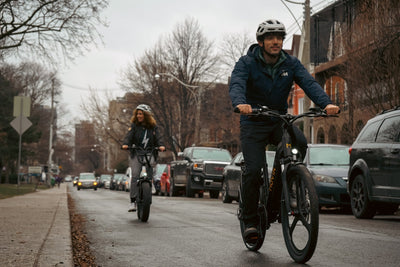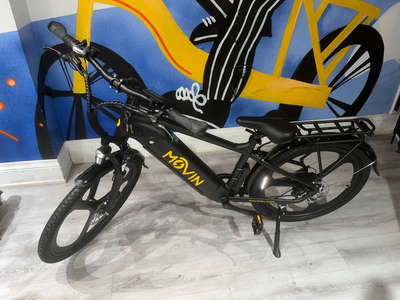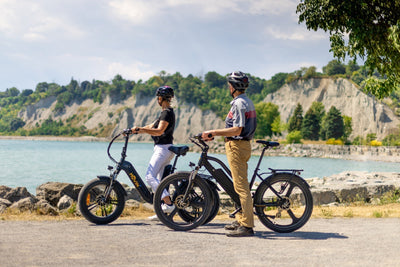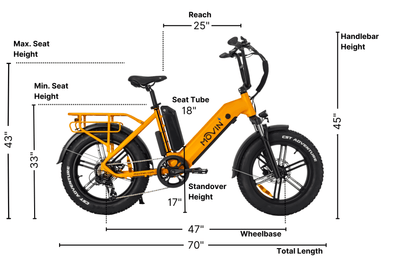Many people are curious: are there special, advanced bicycles that can be operated in more serious conditions than the city? These are fatbikes, which are increasingly found among those who love to ride with the wind. In this article, we will try to explain: why such bicycles are needed, how they differ from the usual ones, give some tips for choosing, and talk about the classification of fatbikes.
The obvious and key advantage – the ability to ride off-road – has already been mentioned above. Let's try to understand what exactly in the construction distinguishes a fatbike from classic bicycles, and briefly analyze the structural features.
Fatbike has wheels with a large thickness provide the ability to overcome the toughest sections where regular bicycles would simply get stuck. The tire width ranges from 3.5 to 4.8 inches, which is significantly more than the usual bicycle norm (two inches). Accordingly, it is this that makes the wheels more functional. At a relatively low pressure, which is about six PSI, the bike easily passes through bumps and potholes. The vehicle's wheels provide excellent traction and practically "spread out" over the surface, thereby softening the vibrations from unevenness. Actually, it is this feature that provides the universality and cross-country ability of the fatbike. At high pressure, which is about twenty PSI, the fatbike can roll on flat roads similar to a mountain bike. By adjusting the pressure level wisely, you can ensure comfortable movement on almost any terrain.
In addition:
- A large handlebar width of about 72 centimeters.
- A specific frame and fork shape: the stays of the rear triangle have a curved geometry, which allows for the installation of thick wheels.
- The weight lies in the range of twelve to nineteen kilograms (slightly exceeding the average bicycle).
Electric fatbikes are equipped with various motors; on average, the power is around 500+ watts. Due to the presence of the motor, the "bicycle" (now one should use this term with caution) is able to cross terrain with loose or friable soil, grass deposits, and other constant "attributes" of off-road conditions with even greater ease. However, the weight of the vehicle increases somewhat. Nonetheless, this does not have a significant negative impact on the dynamics and maneuverability. The simple controls require minimal skills. Another significant plus, distinguishing the bike with an electric drive from a traditional motorcycle, is the ability to move in the classic "bicycle way" using pedals. Note that even if the vehicle's battery runs out and there is no power source nearby, you can continue your journey without any problems.
Of course, the functionality of an electric fatbike far exceeds the capabilities of a classic one. It also wins in comparison with a mountain bike. Such devices will undoubtedly interest people who love extreme riding in off-road conditions. The latter will only add excitement and color but will never become an obstacle that makes further movement impossible. Offhand, one can cite several examples of the off-road capability of the advanced "fat": it is convenient to ride an electric bike on sandy beaches, rocky grounds, marshy terrain, snow crust—the list of locations can go on indefinitely. The presence of a motor allows for a significant expansion of geographical variability, however, one should not slip into idealization: huge obstacles should be bypassed, not attempted to be breached with a frontal attack. It should be noted that such means of transportation are particularly popular in countries with cold climates. Such countries include Canada, where the fatbike indeed gains real relevance. But one aspect should be considered: as with a car, a person who wishes to use the vehicle at any time of the year should stock up on several sets of wheels—for summer and winter periods.
Types of Fatbikes
It has already been noted above that the key advantage of the transport we are describing is the wheels, which ensure an extremely high level of off-road capability. Due to the reduction of air mass inside the tire, a smooth ride is ensured even on the roughest road. The width of the wheels ranges from 3.5 to 5 inches, and the rim itself usually does not exceed ten centimeters. The heaviest element—the wheel—weighs approximately four kilograms, while the entire structure weighs between fourteen and twenty kilograms. However, manufacturers are constantly striving to improve the fatbike—producing various lightweight models.
- Offset. The distinctive feature here is that the center of the rim (or the frame with the fork) is shifted towards the middle part of the vehicle. In this case, the design implies the use of universal hubs and the ability to interchange wheels.
- Non-offset. The distinctive feature is symmetry. Stable wheels that cannot be interchanged with one another are used. Some may consider this a disadvantage, as the difference in standards somewhat complicates the purchase of new tires.
When choosing, one should pay attention to the type of fatbike fork. It can be of a "soft" or "hard" type. Models with a "hard" fork are primarily intended for riding in conditions of sandy roads and snowdrifts. On the other hand, a "soft" fork provides certain shock absorption, which significantly increases comfort when moving on uneven surfaces. It is impossible to definitively prefer one or the other option, as it all depends on the location you plan to travel through.
Also, do not forget that a fatbike should be not only practical but also aesthetically pleasing. It is advisable to prefer models whose color you like and which advantageously highlight your "two-wheeled friend" both within the city and during long trips. One should not underestimate the styling factor: experience shows that it plays a certain role even for people of a pragmatic nature.
Another important criterion for selection is the tread pattern. If you predominantly plan bike rides in urban conditions, it is better to prefer "slick" and "semi-slick" types. For those who anticipate outings in nature, in addition to the main equipment, special mud and gravel tires can be purchased. In winter conditions, tires with a studded tread pattern perform best.
You can learn more about another types of ebikes if you want to compare and make the right choice.
Among the special models, folding fatbikes can be singled out into a separate category. The ability for extremely compact storage is a significant advantage. This is achieved through a specific frame design, which has a large number of joints. If you want to have the ability to travel with a fatbike, for example, to put it in the trunk of a car.
Another special line of products is fatbikes with dual suspension. At the moment, they have not yet become widespread, but soon we will surely see new avant-garde models. Dual suspension can significantly increase the already considerable maneuverability and responsiveness of the transport, as well as improve cross-country ability.
Pros of fatbikes
Partly summarizing, and partly complementing what has been said above, the following advantages of fat bikes can be highlighted:
- Passability. It hardly makes sense to continue to describe the most obvious! It is enough to just look at the fat bike. The high passability, conditioned by the dimensions of the wheels, is a kind of "business card" of this product model. Even with those models that are the least dimensional (for example, the Movin Pulse), you will get the ability to overcome quite "inconvenient" areas and surfaces for bicycles.
- Versatility and functionality. Thanks to the possibility of changing the pressure level, you can move virtually in any conditions. The comfort of movement, even compared to a regular bicycle, will be noticeable not only in extreme off-road conditions but also when riding in the city. The fat bike is practically a universal means of transport.
- Durability. Since the fat bike is primarily oriented for heavy operating conditions, it has high resistance to all possible impacts (low and high temperatures, moisture, and sun rays) and over time does not lose its original appearance and properties. By purchasing such a means of transport, you can be sure that in a few years you will not face the need for replacement. Unfortunately, the same cannot be said about ordinary bicycles.
- Safety. Competent riding on a fat bike — minimal driving requirements are taken into account even by extreme sports enthusiasts — is convenient and, with proper skill, safe. Due to the high quality of all components for the models presented in the catalog of our store, you can be sure that no unpleasant incidents caused by defects or breakdowns will happen to you on the road.
Cons of fatbikes
It should be noted that virtually all the disadvantages of this mode of transportation can be called conditional. For a significant mass of people, they will actually have no meaning. For the sake of fairness, it should be noted that the same applies to advantages, because if you need a bicycle for summer time to ride strictly in urban conditions, buying a fat bike makes no sense. Now let's talk about the downsides:
- Weight. Of course, for a significant slice of the consumer audience, the weight of the vehicle will be a substantial disadvantage. The weight can reach up to twenty kilograms and almost never drops below fourteen kilos. This is not surprising when you recall the dimensions of the wheels: a large mass is a kind of "price" for passability. For some people, this characteristic may simply be uncomfortable due to health conditions or due to age.If weight is an important criterion for you, keep an eye out for our updates. This month we will be introducing a new e-bike model that weighs just 18 kg in total.
- Specific appearance. The “strange” appearance of fat bikes is often noted. The unconventional shape makes it visually similar to something between a motorcycle and a bicycle. This can lead to misunderstandings from those around you: you need to realize that in urban conditions you will constantly attract surprised looks. However, for some people, who enjoy attention from strangers, the specificity of appearance, on the contrary, will be an advantage: with such a bicycle, you will definitely not go unnoticed. And surprise can hardly be called unpleasant, so this point is presented as a disadvantage only for the sake of form.
- Cost. Of course, the average cost of a fat bike is significantly higher than that of a regular city bicycle. Since it is designed for off-road riding, all its components are highly durable — and therefore, are made from special materials. However, you may want to look at the most cost-effective models; for example, Movin Pulse.
- Requirements. Riding a fat bike is as complex as riding a regular mountain bike. However, bear in mind that conquering off-road terrain is not the easiest task. If you do not opt for a model with an electric drive, be prepared that sometimes moving in "unusual" conditions may require certain physical efforts from you.

Average Lifespan of Fat Tires
If you're exploring the world of fat tire bikes, you'll quickly notice that these tires are generally more expensive than typical road or mountain bike tires. This price difference is due to the need for specialized manufacturing processes and the use of more materials in fat tire production. However, the good news is that high-quality fat tires can last for about 2,500 to 3,000 miles under normal use. Think of them as an investment that not only extends your riding season but also enhances your safety.
To ensure that your fat tires serve you well over time, here are some tips to maximize their lifespan:
-
Monitor Tire Pressure: Fat tires work best at lower pressures, which can go down to single-digit PSI levels. However, this can cause significant sidewall flex, leading to wear. On the other hand, over-inflated tires may stress the sidewalls excessively. Adjust your tire pressure based on your riding conditions - lower for better traction on softer terrains and higher for firm surfaces like pavement.
-
Be Mindful of the Riding Surface: Fat tires wear down differently based on the terrain. Riding on softer surfaces like snow or sand causes less wear compared to harder surfaces like asphalt or ice. Choose your tires based on where you predominantly ride; commuting tires differ from those used primarily on snowy trails.
-
Regular Cleaning: Keep your tires clean by wiping them down with a rag and isopropyl alcohol. This not only removes salt and debris but also gives you a chance to inspect for damage or wear. While some sidewall cross-hatching is normal due to flexing, be wary of any visible openings.
-
Proper Storage: Protect your tires from UV rays and temperature changes by storing your bike indoors. Short-term outdoor storage is fine, but prolonged exposure can damage the tires. If you switch tires for different seasons or put your fat bike away for a while, store the tires properly. Remove them, clean thoroughly with alcohol, ensure there's no leftover tubeless sealant (if used) inside, and store in a cool, dry place away from sunlight. If possible, hang the tires to prevent any permanent creasing.
By following these guidelines, you can significantly extend the life of your fat tires, making the most of your investment and enjoying a safer, more enjoyable riding experience.
Concluding the analysis of electric fat bikes, it's noteworthy that, contrary to many widespread stereotypes, their prices are not so high. Of course, they are significantly more expensive than regular bicycles, but such a purchase can hardly be called unaffordable. For instance, even for less than 2500 cad, you can acquire an excellent fat tires ebike from a manufacturer that hardly needs any recommendations. When choosing a product, do not forget to pay attention to a quite important point — the size of battery and motor quality, they directly affect the price.
We hope this text was useful to you, and we wish you success in choosing a fat bike that is right for you! If you have any additional questions, we are waiting for you at 654 College street, Toronto (Movin Ebikes). We are help you to find one of the best fat tires e-bike on the market.








